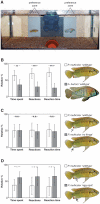A sensory bias has triggered the evolution of egg-spots in cichlid fishes
- PMID: 22028784
- PMCID: PMC3196499
- DOI: 10.1371/journal.pone.0025601
A sensory bias has triggered the evolution of egg-spots in cichlid fishes
Abstract
Although, generally, the origin of sex-limited traits remains elusive, the sensory exploitation hypothesis provides an explanation for the evolution of male sexual signals. Anal fin egg-spots are such a male sexual signal and a key characteristic of the most species-rich group of cichlid fishes, the haplochromines. Males of about 1500 mouth-brooding species utilize these conspicuous egg-dummies during courtship--apparently to attract females and to maximize fertilization success. Here we test the hypothesis that the evolution of haplochromine egg-spots was triggered by a pre-existing bias for eggs or egg-like coloration. To this end, we performed mate-choice experiments in the basal haplochromine Pseudocrenilabrus multicolor, which manifests the plesiomorphic character-state of an egg-spot-less anal fin. Experiments using computer-animated photographs of males indeed revealed that females prefer images of males with virtual ('in-silico') egg-spots over images showing unaltered males. In addition, we tested for color preferences (outside a mating context) in a phylogenetically representative set of East African cichlids. We uncovered a strong preference for yellow, orange or reddish spots in all haplochromines tested and, importantly, also in most other species representing more basal lines. This pre-existing female sensory bias points towards high-quality (carotenoids-enriched) food suggesting that it is adaptive.
Conflict of interest statement
Figures



References
-
- Verheyen E, Salzburger W, Snoeks J, Meyer A. Origin of the superflock of cichlid fishes from Lake Victoria, East Africa. Science. 2003;300:325–329. - PubMed
-
- Fryer G, Iles TD. The cichlid fishes of the Great Lakes of Africa: Their biology and Evolution. Edinburgh: Oliver & Boyd; 1972. 641
-
- Salzburger W. The interaction of sexually and naturally selected traits in the adaptive radiations of cichlid fishes. Mol Ecol. 2009;18:169–185. - PubMed
-
- Kocher TD. Adaptive evolution and explosive speciation: the cichlid fish model. Nature Rev Genet. 2004;5:288–298. - PubMed
Publication types
MeSH terms
Grants and funding
LinkOut - more resources
Full Text Sources
Molecular Biology Databases

